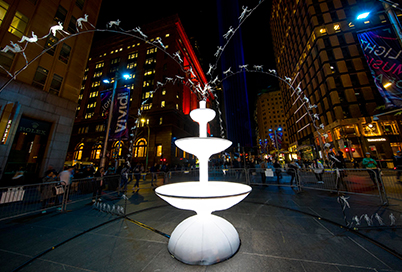
We caught up with third-year NIDA Staging student Taylor Hill to speak about the challenges and rewards of her cohort’s most recent project – building a light installation for Vivid Sydney.
One of the things I love about NIDA’s Bachelor of Fine Arts (Staging) course is the practical hands-on nature of the course, and this year has been no different with the highlight of working on a light project for Vivid Sydney.
We, the second-year Staging students, were selected together with Ample Projects and S1T2 to construct a light installation, the Fountain – a 3-metre high geometric Mountain of Light, which live-streams the global birth rate data as ‘human water droplets’ that emerge from the Fountain’s water jets, shoot skywards, float to the ground, land on their feet and then walk into the distance.
This announcement was met with huge excitement by all of us as Vivid Sydney is one of the festival highlights of the year.
To begin, we met with Ample Projects and S1T2 to discuss materials, size, placement and budget of the installation. We then drafted a construction process for the build, a primary stepping-stone for all staging projects.
After completing this schedule, we quickly realised that the timing of this project was extremely tight – we only had 14 hours allocated to build the installation! Despite this deadline, we were not disheartened and wasted no time in getting everything in order. This included completing construction drawings for the build, receiving approval, and then starting construction.
The construction began with the building of the mould/shell of the fountain bowls. This included: sectioning the bowls into one eighth parts, making the mould out of plywood and foam, duplicating the mould eight times, securing all pieces together with small nails to form the bowls, and then using builders bog and a sander to create a smooth finish.
We then melted thin pieces of plastic over each of the bowl moulds, making it more durable for the sculpture’s final outside setting, Martin Place.
For the steel aspect of our build, we engaged a company to make the rolled steel, which we welded together to form the metal skeleton for the Fountain. This skeleton was a vital part, as it is what held everything in place, including the ‘human water droplets’.
The build of the metal skeleton included welding and moulding the rolled steel into shapes to hold and connect the three fountain bowls. We also created long ark-shaped steel poles with spikes that were used to support the figurines.
Once each of the metal components were constructed, all the different aspects of the Fountain were pre-fitted, meaning everything was constructed and de-constructed at NIDA to ensure everything fitted together before the bump-in at Martin Place.
The final part of the build was, from our perspective, the most challenging and rewarding as a professional props caster was hired to teach us the process of making the miniature ‘human water droplets’. It included printing out 3D figures, and using modelling clay, Pinkysil (liquid that hardens to a rubber-like substance), plaster and acrylic resin to complete the look.
In the end, we made more than 300 moulds to produce the five perfect sets of 25 miniature figurines needed for the installation. Despite a few hiccups along the way, we managed to send off the last set of ‘human water droplets’ to the lighting company S1T2, who then applied the finishing touches of LED strips to the figures. For the final instalment of the Fountain at Martin Place, the LED strips were attached to a loom (a big long cable) which fed electrical current into the miniature figurines making them light up!
My cohort and I agree that this has been the most rewarding and challenging build we have done thus far. We are so pleased with the outcome and feel very proud and privileged to have been chosen to participate in one of Sydney’s favourite festivals, Vivid Sydney.
Taylor Hill, second-year NIDA Bachelor of Fine Arts (Staging) student
Photography by DestinationNSW.

